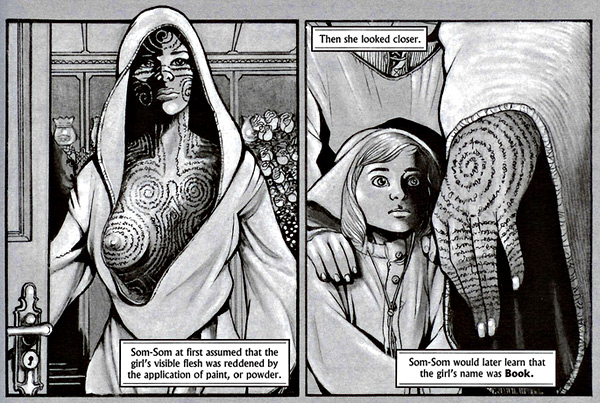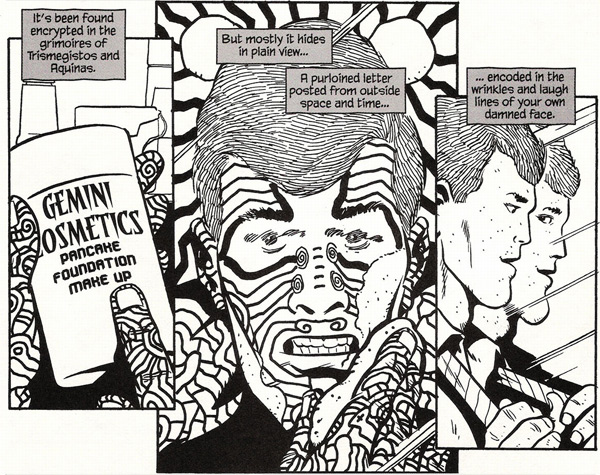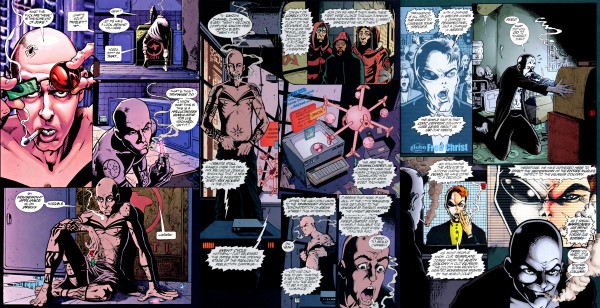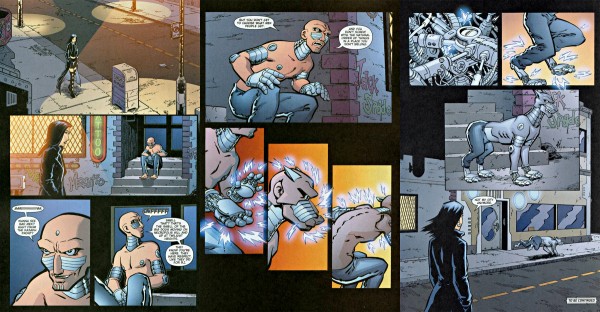Something that’s been on my very long list of “I should do this” projects has been some sort of comprehensive wiki of tattoos and body modification in comics and graphic novels (and another one for film and television might be great as well now that I think about it — assuming it doesn’t already exist). Perhaps it would be a nice subset addendum to the BME wiki (wiki.bme.com). I’d love to see it cover everything from casual references to stories that build their central plot around body modification. A la Niven’s sex “what-if” sex conundrum Man of Steel, Woman of Kleenex, can Superman even get inked? Perhaps with a Kryptonite tattoo needle?
In any case, the “Body Mods in Comics Wiki” project came to mind again this afternoon as I re-read Alan Moore’s Hypothetical Lizard and saw the character “Book”, whose skin is covered in swirling spiraling patterns that are actually lines of text — a motif I’m surprised I’ve never seen explored this effectively in reality.

I was also recently prodded when Rafa changed his avatar to a picture of Spider Jerusalem, one of the greatest heaily tattooed comic book characters of all time, the “plausible dystopia” version of Hunter S. Thompson from Warren Ellis‘s brilliant epic 60-issue Transmetropolitan series (also available as a ten volume collection). Click the picture (and you can do this with the Mek and Skin Graft images too) to actually read the little excerpt, but trust me, everything I’m mentioning in this post is worth the purchase — especially this.
Speaking of Warren Ellis (the author of Transmetropolitan), it’s quite common to see body modification in his stories, and in the past he’s linked to ModBlog’s more “upsetting” entries. Also in Transmetropolitan is “Fred Christ”, leader of a “Transient” cult, a sort of transhumanist cyberpunk Church of Body Modification with a little inter-species fun thrown in for good measure. After Transmetropolitan wrapped up its print run, Ellis further explored these ideas in a short three-issue story — which I can not recommend highly enough — called MEK, as in “Massive Enhancement Culture” or body modification beyond simple aesthetics. I admit that I secretly (not any more I suppose) pretend that I was the inspiration for the main character who leans the MEK movement, because I feel like if you played a “who said this” quote game it would be easy for people to guess wrong — Lepht might also fit the role well. In any case, Mek is perhaps the best body modification themed comics, although it got unfortunately mixed reviews from the critics when it was released and is now out of print — although it’s not hard to find it used at inexpensive prices.
Another comic that’s got body modification as a central theme is Rick Veitch’s surreal masterpiece Can’t Get No, in which a failed businessman — failed, amusingly, because his permanent marker company was sued to death over the graffiti its product makes possible — wakes up one day covered in head-to-toe tattoos, drawn on with those very markers by cackling women as he lies passed out drunk. The comic showing us his psychedelic nightmare of a journey through post-9/11 America (the attacks taking place not long after his marked affliction).

More obviously — and a much more traditional comic — I’m also thinking of Skin Graft: The Adventures of a Tattooed Man a four-part horror thriller in which explores ideas like the the souls of a serial killer’s victims becoming consumed by the tattoos he wears — admittedly an overdone idea, but effectively tackled by writer Jerry Prosser — and sacred tattoos gifted by a master or teacher that give the wearer power.
There are many, many more examples, enough I feel to justify a wiki, not just blog posts.
And finally while I’m on this subject — and I think there may be a space in such a wiki for this sort of general trivia — I have to throw out a plug for artist Jacen Burrows. If I see him credited as the artist in a comic I always take the time to check it out. Before becoming a star in the comic world — you may know him from projects like Alan Moore’s Necronomicon or the notorious, over-the-top perverse and violent Crossed series — he was a tattoo artist. I suspect he’s not the only tattoo artist that has worked in both industries, because in many ways the demands are similar, namely, producing copious amounts of custom art on brutally short deadlines for demanding clients that need you to inject your unique artistic vision into a scene without betraying their original literary concept. Neither one is an easy life, but both bring great joy.
What do you think? Would you like to see this? And perhaps more importantly, would you be willing to help?


